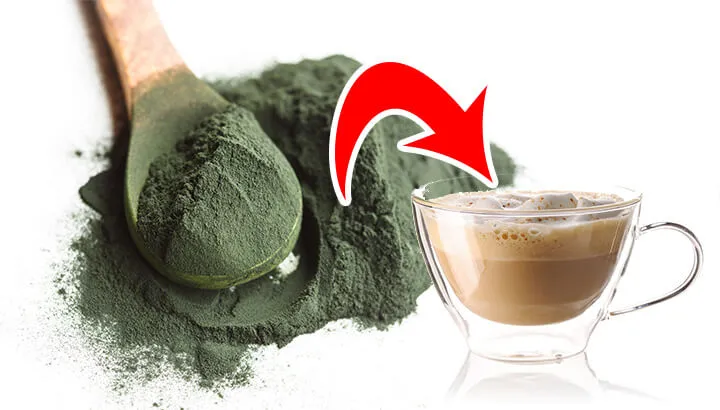Are you a coffee aficionado looking to boost your morning brew with a nutritional powerhouse? If you’ve ever wondered, “Can I add spirulina to my coffee?” then you’re in for a treat! In this article, we’ll dive into the fascinating world of spirulina and explore the potential benefits, drawbacks, and creative ways to incorporate this superfood into your daily cup of joe. So grab your favorite mug and let’s uncover the perfect blend of taste and health!
Can I Add Spirulina to My Coffee?
With its remarkable nutrient profile and potential health benefits, spirulina, a microalga, has gained prominence in the realm of superfoods. Its versatility extends beyond smoothies and supplements, captivating the curiosity of coffee aficionados seeking a unique twist to their morning brew. In this comprehensive guide, we delve into the intriguing question: Can spirulina be harmoniously blended with coffee, exploring the potential advantages and drawbacks of this unconventional combination.
Unveiling the Nutritional Treasures of Spirulina
Spirulina’s status as a nutritional powerhouse is undeniable. It boasts an impressive array of essential vitamins, minerals, and antioxidants, including vitamin A, B-vitamins, vitamin C, vitamin E, calcium, copper, magnesium, manganese, and potassium. Additionally, it is a rich source of iron, making it an attractive option for vegetarians and vegans seeking to boost their iron intake.
Beyond its vitamin and mineral content, spirulina is a treasure trove of phytonutrients, including chlorophyll, beta-carotene, and phycocyanin, which have been linked to various health benefits. Its protein content is also noteworthy, with an impressive 60-70% of its dry weight composed of amino acids, the building blocks of protein.
Potential Health Benefits of Blending Spirulina with Coffee

While research specifically investigating the combined effects of spirulina and coffee is limited, there is evidence suggesting that this unique pairing may offer several potential health benefits:
1. Enhanced Antioxidant Activity:
Spirulina is a potent source of antioxidants, including phycocyanin, which has been shown to combat oxidative stress, a major contributor to aging and various chronic diseases. Combining spirulina with coffee, which also contains antioxidants, may further enhance the body’s defense against free radical damage.
2. Boosted Energy Levels:
Coffee is renowned for its ability to elevate energy levels and improve cognitive function, thanks to its caffeine content. The addition of spirulina, with its rich nutrient profile, may provide sustained energy throughout the day, potentially reducing the need for multiple caffeine boosts.
3. Improved Nutrient Absorption:
Spirulina’s high chlorophyll content may enhance the absorption of certain nutrients from coffee, such as magnesium and potassium. Additionally, spirulina’s alkaline properties may help neutralize the acidity of coffee, reducing potential digestive discomfort.
Potential Drawbacks and Considerations
While the combination of spirulina and coffee may offer potential benefits, there are a few drawbacks and considerations to keep in mind:
1. Altered Coffee Taste:
Adding spirulina to coffee may alter its taste, imparting a slightly earthy or bitter flavor. Some individuals may find this taste undesirable, especially if they prefer the traditional flavor of coffee.
2. Potential Side Effects:
Consuming excessive amounts of spirulina may lead to side effects such as nausea, vomiting, diarrhea, and headaches. It is essential to start with a small amount and gradually increase intake to minimize the risk of adverse reactions.
3. Interaction with Medications:
Spirulina may interact with certain medications, including blood thinners and immune suppressors. Individuals taking medications should consult with their healthcare provider before consuming spirulina.
Start your journey >> What is Cream for Coffee? Unveiling the Secret to Perfectly Creamy Brews
Creative Ways to Incorporate Spirulina into Coffee
If you’re intrigued by the potential benefits of combining spirulina and coffee but are hesitant about the taste, there are several creative ways to incorporate spirulina into your coffee routine:
1. Spirulina-Infused Coffee Beans:
Some coffee brands offer spirulina-infused coffee beans, which provide a subtle spirulina flavor without overpowering the coffee’s taste.
2. Spirulina Powder:
Sprinkle a small amount of spirulina powder into your coffee grounds before brewing. Start with a small amount and gradually increase it to suit your taste preferences.
3. Spirulina Latte:
Create a vibrant and nutrient-rich latte by blending spirulina powder with steamed milk and a shot of espresso. Top it off with frothed milk and a sprinkle of spirulina powder for an Instagram-worthy drink.
4. Spirulina Smoothie:
Combine spirulina powder, coffee, frozen banana, yogurt, and almond milk in a blender for a refreshing and nutritious smoothie.
A Balancing Act of Taste and Health
The decision to add spirulina to your coffee is a personal choice, influenced by your taste preferences and health goals. While spirulina offers an array of nutritional benefits, it’s essential to start slowly to avoid potential side effects. Experiment with different methods of incorporating spirulina into your coffee routine until you find a combination that suits your palate and health needs.
Q: What are the vitamins and minerals found in spirulina?
A: Spirulina contains a wealth of vitamins and minerals, including vitamin A, B-vitamins, vitamin C, vitamin E, calcium, copper, magnesium, manganese, and potassium.
Q: Is spirulina a good source of iron?
A: Yes, spirulina is a great choice for vegetarians and vegans due to its high iron content.
Q: Can I mix spirulina with coffee?
A: Yes, you can mix spirulina with coffee for an early morning boost. The rich, earthy flavor of spirulina can complement the taste of coffee.
Q: How can I offset the earthy flavor of spirulina when adding it to drinks?
A: The rich, earthiness of spirulina’s flavor can be offset by naturally sweet juice, such as orange or pineapple juice. It can also be mixed into sweet smoothies to mask its flavor.
Q: What are some other ways to incorporate spirulina into food?
A: Spirulina can be added to scrambled eggs, omelettes, smoothies, bread dough, and even used to make blue-green tortillas for a different flavor and nutritional profile.

